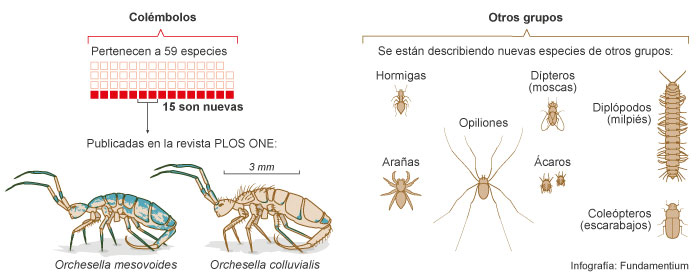15 new species discovered in a little explored biotope of the Sierra de Guadarrama
Described by biologists from the University of Navarra, the project has been coordinated by the University of Alcalá de Henares in Madrid.

A group of biologists from the universities of Alcalá (to which belongs the researcher that coordinates the project), Navarra (with two zoologists who have described the invertebrates), Almería, Granada and Valencia has detailed for the first time the biodiversity hidden in a virtually unexplored biotope of the Sierra de Guadarrama National Park, in Madrid-Segovia, the last enclave that acquired the category of national park in Spain, in 2013.
In this place - specifically, in the canchales or accumulations of rocks on mountain slopes - is where the scientists installed 33 subway sampling stations at a depth of one meter, with the goal to collect invertebrates that live in the holes that remain between the rocks. In total, 157,000 specimens were collected during the two years of the study, of which 48% were springtails and the rest belonged to other groups of arthropods, such as arachnids, myriapods (millipedes, centipedes), crustaceans (damp woodlice) and insects (flies, beetles, ants, crickets, etc.).
"Among the springtails we identified individuals of 59 different species. At least 15 of them are new to science, as they had not yet been described anywhere else on the planet," say two of the authors, Enrique Baquero and Rafael Jordana, zoologists from the School of Sciences of the University of Navarra and in charge of describing the new species found.
"All of them," add the two experts, "are species adapted to live in that particular biotype, with certain similarities to the conditions that occur in spaces subject caves - lack of light, high humidity and small variations in temperature - but with the peculiarity that they have more nutrient input that comes from the soil itself."
Living indicators of climate changeSpringtails are small invertebrates (arthropods) that have very short reproductive cycles and breathe through their skin, "which is why they are very sensitive to any change in their environment. Through their study we can know, relatively quickly, how they are affected by changes caused by climate change, increased temperatures or reduced rainfall," says Baquero, director of Master's Degree in Biodiversity, Landscapes and Sustainable management of the academic center.
While some ecosystems have been studied in depth, the authors of the study add that this biotope - known as the Surficial Subsurface Environment (SSM) - is relatively new to science. Formed from colluvial deposits (derived from the entrainment and deposition of rocky materials from the erosion of bedrock), it was discovered in the early 1980s in other mountain enclaves in Europe. Now experts stress that it could also be used as a true bioindicator, or living indicator, of the status environmental quality in such sensitive environments as natural parks.
This study -graduate "Distinctive Collembola communities in the Mesovoid Shallow Substratum: First data for the Sierra de Guadarrama National Park (Central Spain) and a description of two new species of Orchesella (Entomobryidae)"- has been supported by the Organismo Autónomo Parques Nacionales with the participation of experts from different specialties. The results have also been published in one of the journals with the highest impact of its specialization program, PLOS ONE, with a PI of 2.8.
-
You have a fully editable infographic that you can publish in your print or digital media. Download it here.
